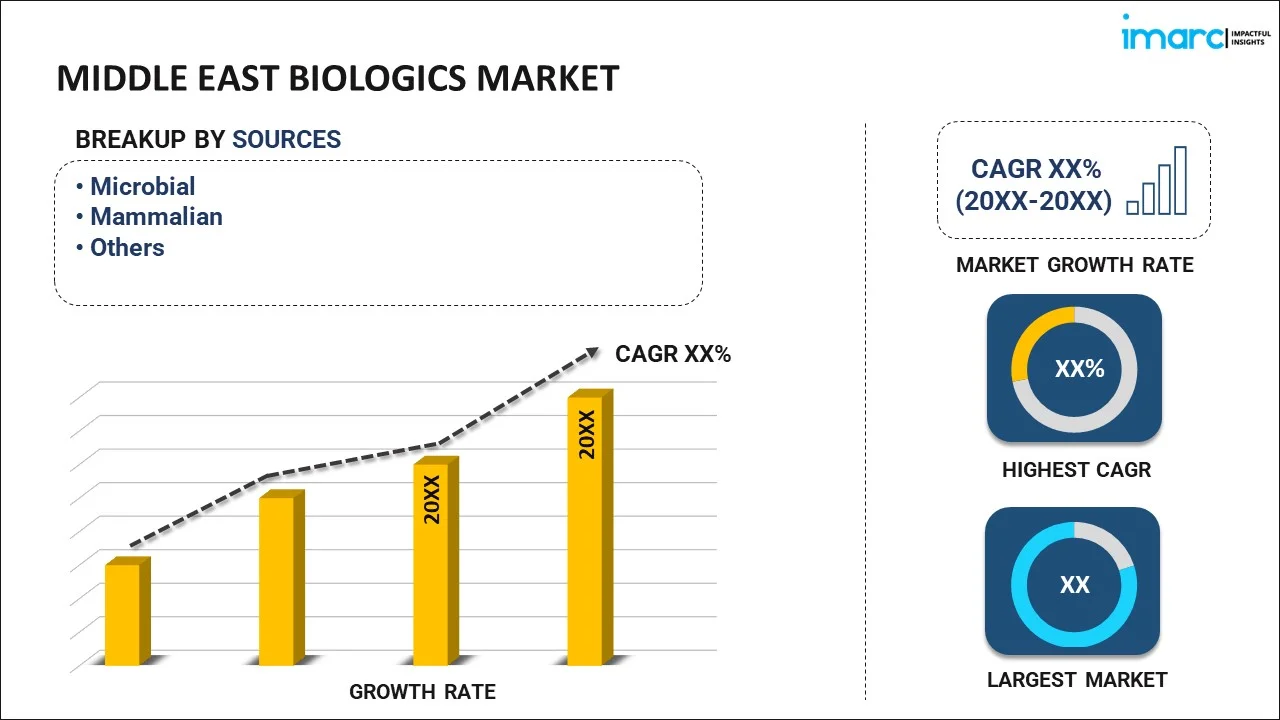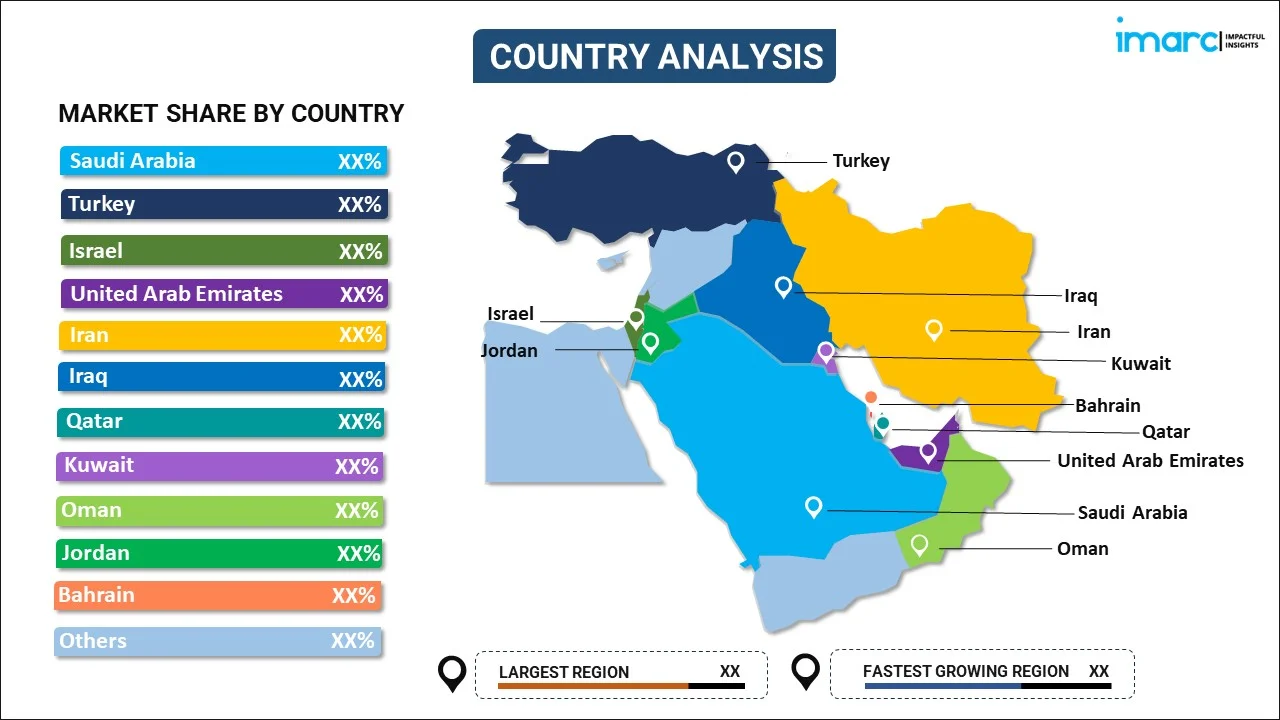
Middle East Biologics Market Report by Source (Microbial, Mammalian, and Others), Product (Monoclonal Antibodies, Vaccines, Recombinant Proteins, Antisense, RNAi and Molecular Therapy, and Others), Disease (Oncology, Immunological Disorders, Cardiovascular Disorders, Hematological Disorders, and Others), Manufacturing (Outsourced, In-House), and Country 2024-2032
Market Overview:
Middle East biologics market size is projected to exhibit a growth rate (CAGR) of 7.06% during 2024-2032. The ongoing developments in biotechnology, including gene therapy, monoclonal antibodies, and recombinant DNA technology, which enable the production of innovative and complex biological drugs, are driving the market.
|
Report Attribute
|
Key Statistics
|
|---|---|
|
Base Year
|
2023 |
|
Forecast Years
|
2024-2032
|
|
Historical Years
|
2018-2023
|
| Market Growth Rate (2024-2032) | 7.06% |
Biologics are a class of medicinal products derived from living organisms or their components, utilizing biotechnology processes. Unlike traditional drugs synthesized through chemical means, biologics are complex molecules such as proteins, antibodies, or nucleic acids. These substances are designed to target specific pathways or components within the body, often to treat complex diseases like cancer, autoimmune disorders, and certain infections. Biologics can be produced using genetically modified cells, typically bacteria or mammalian cells, to express the desired therapeutic proteins. Due to their intricate nature, biologics are often more specific in their action and may have fewer side effects compared to conventional drugs. They play a crucial role in modern medicine, offering innovative and targeted therapies that can improve patient outcomes and quality of life.
Middle East Biologics Market Trends:
The biologics market in the Middle East is propelled by a confluence of factors, primarily due to the increasing prevalence of complex diseases. As the regional population ages, the demand for targeted and personalized therapies has surged, driving pharmaceutical companies to invest heavily in the development of biologics. Additionally, the rise of chronic conditions, such as autoimmune disorders and cancer, has spurred the need for innovative treatment options that can offer enhanced efficacy with reduced side effects. Furthermore, collaborative efforts between academia and industry players have accelerated the pace of biologics R&D. The intricate web of interconnected scientific disciplines has fostered a holistic approach to understanding the biological mechanisms underlying diseases, paving the way for the design of more effective biological therapies. In parallel, regulatory agencies have adapted to the dynamic landscape, streamlining approval processes for biologics and fostering a conducive environment for market growth. Moreover, the growing awareness among healthcare professionals and patients about the benefits of biologics that not only target the symptoms but also address the underlying molecular and cellular aberrations driving disease progression is expected to drive the market in the Middle East during the forecast period.
Middle East Biologics Market Segmentation:
IMARC Group provides an analysis of the key trends in each segment of the market, along with forecasts at the regional and country levels for 2024-2032. Our report has categorized the market based on source, product, disease, and manufacturing.
Source Insights:

- Microbial
- Mammalian
- Others
The report has provided a detailed breakup and analysis of the market based on the source. This includes microbial, mammalian, and others.
Product Insights:
- Monoclonal Antibodies
- Vaccines
- Recombinant Proteins
- Antisense, RNAi and Molecular Therapy
- Others
A detailed breakup and analysis of the market based on the product have also been provided in the report. This includes monoclonal antibodies, vaccines, recombinant proteins, antisense, RNAi and molecular therapy, and others.
Disease Insights:
- Oncology
- Immunological Disorders
- Cardiovascular Disorders
- Hematological Disorders
- Others
The report has provided a detailed breakup and analysis of the market based on the disease. This includes oncology, immunological disorders, cardiovascular disorders, hematological disorders, and others.
Manufacturing Insights:
- Outsourced
- In-House
A detailed breakup and analysis of the market based on the manufacturing have also been provided in the report. This includes outsourced and in-house.
Country Insights:

- Saudi Arabia
- Turkey
- Israel
- United Arab Emirates
- Iran
- Iraq
- Qatar
- Kuwait
- Oman
- Jordan
- Bahrain
- Others
The report has also provided a comprehensive analysis of all the major regional markets, which include Saudi Arabia, Turkey, Israel, United Arab Emirates, Iran, Iraq, Qatar, Kuwait, Oman, Jordan, Bahrain, and Others.
Competitive Landscape:
The market research report has also provided a comprehensive analysis of the competitive landscape. Competitive analysis such as market structure, key player positioning, top winning strategies, competitive dashboard, and company evaluation quadrant has been covered in the report. Also, detailed profiles of all major companies have been provided.
Middle East Biologics Market Report Coverage:
| Report Features | Details |
|---|---|
| Base Year of the Analysis | 2023 |
| Historical Period | 2018-2023 |
| Forecast Period | 2024-2032 |
| Units | US$ Million |
| Scope of the Report | Exploration of Historical and Forecast Trends, Industry Catalysts and Challenges, Segment-Wise Historical and Predictive Market Assessment:
|
| Sources Covered | Microbial, Mammalian, Others |
| Products Covered | Monoclonal Antibodies, Vaccines, Recombinant Proteins, Antisense, RNAi and Molecular Therapy, Others |
| Diseases Covered | Oncology, Immunological Disorders, Cardiovascular Disorders, Hematological Disorders, Others |
| Manufacturings Covered | Outsourced, In-House |
| Countries Covered | Saudi Arabia, Turkey, Israel, United Arab Emirates, Iran, Iraq, Qatar, Kuwait, Oman, Jordan, Bahrain, Others |
| Customization Scope | 10% Free Customization |
| Report Price and Purchase Option | Single User License: US$ 3699 Five User License: US$ 4699 Corporate License: US$ 5699 |
| Post-Sale Analyst Support | 10-12 Weeks |
| Delivery Format | PDF and Excel through Email (We can also provide the editable version of the report in PPT/Word format on special request) |
Key Questions Answered in This Report:
- How has the Middle East biologics market performed so far and how will it perform in the coming years?
- What has been the impact of COVID-19 on the Middle East biologics market?
- What is the breakup of the Middle East biologics market on the basis of source?
- What is the breakup of the Middle East biologics market on the basis of product?
- What is the breakup of the Middle East biologics market on the basis of disease?
- What is the breakup of the Middle East biologics market on the basis of manufacturing?
- What are the various stages in the value chain of the Middle East biologics market?
- What are the key driving factors and challenges in the Middle East biologics?
- What is the structure of the Middle East biologics market and who are the key players?
- What is the degree of competition in the Middle East biologics market?
Key Benefits for Stakeholders:
- IMARC’s industry report offers a comprehensive quantitative analysis of various market segments, historical and current market trends, market forecasts, and dynamics of the Middle East biologics market from 2018-2032.
- The research report provides the latest information on the market drivers, challenges, and opportunities in the Middle East biologics market.
- Porter's five forces analysis assist stakeholders in assessing the impact of new entrants, competitive rivalry, supplier power, buyer power, and the threat of substitution. It helps stakeholders to analyze the level of competition within the Middle East biologics industry and its attractiveness.
- Competitive landscape allows stakeholders to understand their competitive environment and provides an insight into the current positions of key players in the market.
Need more help?
- Speak to our experienced analysts for insights on the current market scenarios.
- Include additional segments and countries to customize the report as per your requirement.
- Gain an unparalleled competitive advantage in your domain by understanding how to utilize the report and positively impacting your operations and revenue.
- For further assistance, please connect with our analysts.
 Inquire Before Buying
Inquire Before Buying
 Speak to an Analyst
Speak to an Analyst
 Request Brochure
Request Brochure
 Request Customization
Request Customization




.webp)




.webp)












